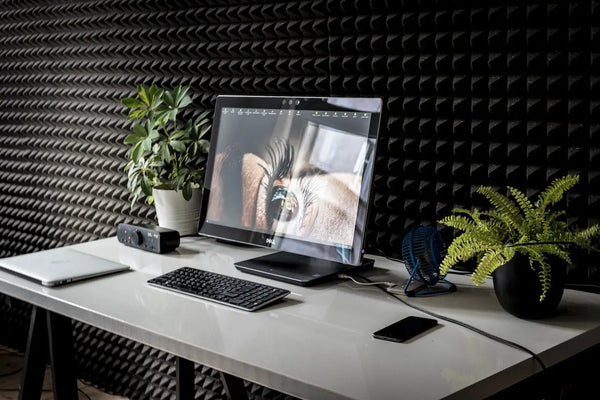What are the best office plants? and integrating nature in your office
Whether you design a new office space or are looking for ways to renew your existing space, office plants are a great way to add unique design elements. Moreover, plants are extremely useful in the workplace.
Keep reading to find out how you choose the best plant for your office and which plants you should avoid.

Advantages of office plants
There are many reasons to love house plants, making them popular in houses, offices and other companies. House plants are certainly nice to look at and they offer numerous benefits. Office plants can be a very useful addition to any office space.
Advantages of office plants
Improve air quality
According to research into how plants can purify the indoor environment, there are many types of house plants that help improve air quality. A study analyzed various plants to evaluate their ability to remove pollutants from the indoor air. The study showed that there are various plants that can absorb harmful toxins such as benzene and formaldehyde. These plants include:
- Aloe Vera
- Peace Lelies
- Orchids
- Rubber plants
- English ivy
- Areca-Palm
For example, the hose plant can remove nitrogen oxide, benzene, xylene and trichlorethylene. When studying these plants, researchers discovered that the oxygen concentration in the Chamber increased for a certain period and decreased carbon dioxide. By adding these plants to your workspace, your office can get cleaner air, which reduces the chance of becoming sick.
Positivity
Office plants can also improve the mood of your employees. If you know how to integrate nature into office designs, people in your office can feel more connected to nature, which is soothing and relaxing. Spending time outdoors helps to reduce depression and anxiety, so bringing plants inside can have positive effects.
Plants can also improve your feelings because they regulate things like humidity in the air. Something simple if this can help to increase positivity and improve mood, which leads to a more positive and pleasant working environment.
Increase productivity
Research has shown that office plants can significantly increase the satisfaction of employees with their workspace, improve the concentration level and increase involvement in their work. When employees are satisfied at their office, they can concentrate better and be more productive. If you are looking for ways to encourage your employees to be more productive or are looking for ways to increase efficiency, factories can be the solution.
Adds decoration
If there is nothing else, plants serve as a way to access interior spaces. There are many ways to integrate plants in a visual aesthetic way. Plants can even look like art, depending on how they are arranged. They can serve as a central point or just give people something to look at. Filling your office or workspace with plants can make the space more stylish and more pleasant to stay in.

4 best houseplants for offices
Given the benefits of house plants in office spaces, it is only logical that you want to include a few in your office space. How do you know with so many different types of house plants which plant is best for an office? Some house plants need more maintenance than others, so the best office plants are easy to care for and survive in many environments.
4 best houseplants for offices
1. Snake plant
Scientifically known as Sansevieria, snake plants are one of the best options for office plants. They are extremely low in maintenance and their green and yellow swordy leaves will add a unique natural element to every office design while filtering toxins from the air.
Office environments are often difficult for plants to grow in, although snake plants are almost indestructible and even thrive in neglect. For the most part, snake plants grow best when you ignore them. They can long periods without getting water, and giving irregular water helps prevent root rot. Snake plants are extremely versatile, so they can grow on almost any soil type.
Snake plants can tolerate different temperatures and levels of humidity, so they will do well in any office environment. This type of plant thrives in almost every light situation, so whether it is placed in front of a window or is tucked away in a dark angle, your snake plant will work with what it gets. Make sure that you do not place it in direct sunlight, because the direct sun will dry out the leaves and kill the plant.
In general, snake plants are an excellent choice for most office spaces, because they need little maintenance and are easy to please.
2. ZZ factory
Zamioculcas Zamiifolia, or simply ZZ-Plant, is another extremely low-maintenance plant that is doing well to be forgotten. Although they grow slowly, ZZ plants can reach 60 cm high and have nice wide, dark green leaves. These plants, from Africa, are drought tolerant and can handle a few missed casts.
Just like snake plants, ZZ plants tolerate different types of light, soil and temperatures. ZZ plants are known as low-light plants, making them an ideal choice for offices with little natural light. Fleur a dark room with a ZZ plant and at the same time take advantage of its air-filtering properties.
ZZ plants are beautiful plants that are certainly an asset to every room. However, one thing to keep in mind is that ZZ plants are toxic to pets and people when they are swallowed. Although this should not be a problem if your office is only for adults, it might not be a great plant for workspaces with children or pets.
3. Pothos
If your office has little to no natural light and you want to take office plants, no light is not a problem for Pothos. Pothos are known for growing well under fluorescent lighting, because they don't really need sunlight to grow. She helps sunlight to get larger and fuller leaves, but they grow well with little light.
Pothos are also quite low in maintenance in many other ways. They are suitable for most types of soil and do well with intermittent water. Pothos also likes humidity, although dry air is not a problem.
Pothos are hanging plants, which means that their shiny, colorful leaves over the pot in which it is planted. These plants can grow with impressive speeds and would look great in a hanging pot or placed somewhere high so that the leaves can walk down. In addition, Pothos plants are extremely easy to increase, so that you can grow new plants from one pothos.
4. Fat plants
If you are looking for the best plants for windows benches in offices, look for fat plants. While most house plants dry out when they are placed in direct sunlight, fat plants prefer a clear, warm environment. Clear window sills in southern rooms get a lot of direct sunlight, making them ideal for succulents. If your office generally has many windows, place some succulents where they can absorb the natural light.
Success plants are generally a great office plant because they require little maintenance and only occasionally need small amounts of water. You will also notice that there are many different types of succulents, so that you can add variation to your plant displays.

4 office plants to avoid
The best plants for office spaces are usually low in maintenance. As such, the worst office plants often need a lot of maintenance, making it more difficult to take care of them and to keep them alive in an office environment. Try to avoid these four plants unless you have the time and effort needed to take care of plants.
1. FIGARS
Ferns are well-known and easily recognizable plants in both indoor and outdoor spaces. Although they are a sought -after plant because of their beauty, they require quite a lot of maintenance and are difficult to keep satisfied. Ferns can be quite dramatic and will soon let you know when they are unhappy. Humidity is a must for these plants - without sufficient humidity, their leaves will dry out and crumble quickly. As soon as a sail starts to dry out, it is difficult to breathe new life into him.
Because ferns need a lot of moisture and are difficult to please, they are usually not ideal for an office.
2. Violet leaf tree
Fiddle Leaf trees can grow into beautiful, large house plants if they are well cared for. Unfortunately, they are one of the most difficult house plants to keep happy. They require extremely much maintenance and require the perfect soil, humidity levels, sunshine and humidity. Violet leaf trees need a very moist environment, so unless your office is moist, you should probably give this plant your own humidifier.
Because this plant has specific needs and can be difficult to please, try to avoid it in office environments.
3. Orchids
Orchids are beautiful flowering plants that can make a statement in every room. However, there are some disadvantages to these plants, so they are not ideal for an office. Orchids are free -maintenance -friendly, making them very difficult to keep alive. You need really green fingers and a talent for these plants to keep them in bloom and flowering.
They are very picky when it comes to indirect sunlight and have an unreliable watering schedule, making them easy to water or accidentally forget to water. While other plants can tolerate drought, orchids do not. Moreover, orchids can be on the more expensive side, making them a gamble if you don't keep them alive.
4. Flowers
Although many types of flowers are relatively easy to grow outside, they are not ideal for an office space. Flowers can be a nice surprise in the office, but often having inside can be bad for colleagues with allergies. Flowers such as daisies and sunflowers are found most often in outdoor gardens, and when they are brought in, they bring large amounts of pollen.
Pollen is one of the most common causes of seasonal allergies and many of your colleagues can struggle with their allergies outside the office. To be courteous, it is best to grow flowers outside instead of at the office.

How do you choose the best plant for your office?
Knowing how to choose office plants is essential to choose plants that will thrive. There are many factors that influence how well plants grow or fit in your office. Here are three considerations that will help you determine the best plant for your office:
Lighting in your office: A large aspect of your office that you have to take into account is the lighting. Do you receive a lot of natural light, no or somewhere in between? The amount of natural light will limit your search for plants, because some plants have specific sunlight needs. The best plant for your office has light needs that reflect what your office has to offer.
Maintenance requirements: As we mentioned earlier, different factories have different maintenance requirements. Consider how much time you can or want to spend on the maintenance of your plants, in addition to completing your work. You may need to designate team members to take care of certain plants to prevent neglect or too much water.
Children and pets: Another consideration that is often overlooked when choosing plants are the people and animals that will regularly be around them. Some plants are toxic when they are taken by people or pets. Therefore choose pet and child-friendly plants if you work with these groups.
How can you integrate office plants in office design?
With an idea of which plants you should include in your office, you may still wonder how to rank your office plants. The answer to that question depends on which plants you choose and what kind of office space you have. However, there are some ideas here to help you on your way.
Add high plants to empty corners
Corners can be a challenge to decorate in offices, especially if the space is limited. Fortunately, plants can be a great way to add some decor to those empty corners. High plants such as palms or dracaenas can be bone in a large pot directly on the floor instead of on a table, desk or box. With minimal effort, heights and variety adds to your workspace with minimal effort.
Construction of living walls
If you are looking for an extravagant way to integrate plants and nature into your office, consider adding a living wall. Living walls take a variety of plants, ranging from moss to ivy, and plants them in a wall so that they can grow on a vertical surface instead of horizontal. Living walls are really a feast for the eyes and would be an impressive addition to every room.
Use a variety of plants
Knowing how many plants you should have in your office can be difficult. Many would say the more the better, but you do not want plants to reduce the productivity of your employee. As long as they do not stand in the way of business operations, it is beneficial to have several plants, and a variety of different plants ensures more visual attraction.





